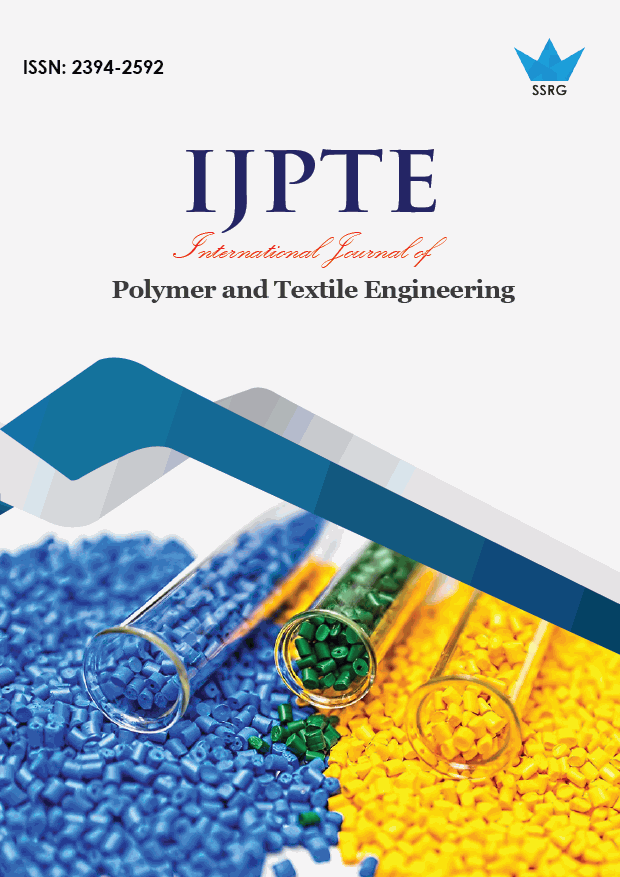An Investigation of Eco-friendly Enzyme Washing Process in Denim Apparel

| International Journal of Polymer and Textile Engineering |
| © 2020 by SSRG - IJPTE Journal |
| Volume 7 Issue 1 |
| Year of Publication : 2020 |
| Authors : Asif Shahriar |
How to Cite?
Asif Shahriar, "An Investigation of Eco-friendly Enzyme Washing Process in Denim Apparel," SSRG International Journal of Polymer and Textile Engineering, vol. 7, no. 1, pp. 29-38, 2020. Crossref, https://doi.org/10.14445/23942592/IJPTE-V7I1P104
Abstract:
Denim garment is the most preferred of today’s youth. This project presents the effect of enzyme & enzyme stone washes using cellulose enzyme on the properties of denim garments to develop novel design and fashion. Three parameters in enzyme washing namely concentration of enzyme, washing temperature and time at pH 5.5 were considered. To investigate the optimum washing condition, indigo dyed cotton denim garments were chosen and processed by enzyme with the concentration of 0.5% to 3.5%, temperature 40°C to 70°C and time 20 min to 60 min for the achievement with desired worn and aged effect. The effect of each parameter is discussed, and denim garment’s properties like tensile strength, elongation at break, weight loss, stiffness, water absorption, shrinkage, color fading and morphological values by SEM were evaluated. The optimized washing condition for the best value is 2% enzyme concentration at 55°C for 40 min.
As denim is one of the tradition item and the denim washing have very stable performance. However, there are some of the comments that when the fabric has longer washing time, use of the chemical on the washing procedure will affect the physical performance such as the tensile strength will decrease. In order to achieve an optimum the effect of washing process on the denim woven fabric in different washing time, Enzyme Wash, Enzyme wash with bleach, Enzyme wash with stone and Enzyme wash with stone and bleach were carried out for cotton and cotton - spandex denim fabric. The effect of the washing parameters, such as the temperature, time and pH on the result of the cotton and cotton spandex denim after treatment were studied by assessment of the tensile physical properties and elongation to break.
The study concluded that cellulase treated in cotton and cotton denim got a larger various change than the original denim. The cellulase treatment decreases the strength of the properties of the tensile strength and elongation to break
Keywords:
Denim, Enzyme, Washing, Eco-friendly
References:
[1] Kashem, M. A. (2008), Garments Merchandising, 1st edn, Lucky-One Traders, Dhaka, Bangladesh, Pp. 69-71.
[2] J. Webster, R.M. Laing, 1998, Fibres to Finished Fabric proceedings, 173 – 174.
[3] Kathryn L. Hatch, 1993, Textile Science, West Publishing Company, 164 – 167, 245 – 251.
[4] American Association of Textile Chemists and Colorists, AATCC Test Method 20-2007, Fiber Analysis: Qualitative, AATCC Technical Manual 2008, 44
[5] Ayesha Saleem, Somia Ali , Iraj Anjum , Fatima Anwar, “Challenges and Strategies for Sales Prediction in Apparel Industry”, SSRG International Journal of Computer Science and Engineering, Volume 6 Issue 8– Aug 2019.
[6] Grieve, M., Biermann, T. and Schaub, K.(2006), The use of indigo derivatives to dye denimmaterial, Science & Justice, 46:15-24.
[7] Islam, M. T. (2010), Garments Washing & Dyeing, Ananto Publications, Dhaka, , Pp. 220-222.
[8] Buchert, J. and Heikinheimo, L. (1998), New cellulase processes for the textile industry, Carbohydr. Eur. 22: 2-4.
[9] Duran, N. and Marcela, D., (2000), Enzyme applications in the textile industry, Review Progress in Coloration, 30 (1): 41-44.

 10.14445/23942592/IJPTE-V7I1P104
10.14445/23942592/IJPTE-V7I1P104